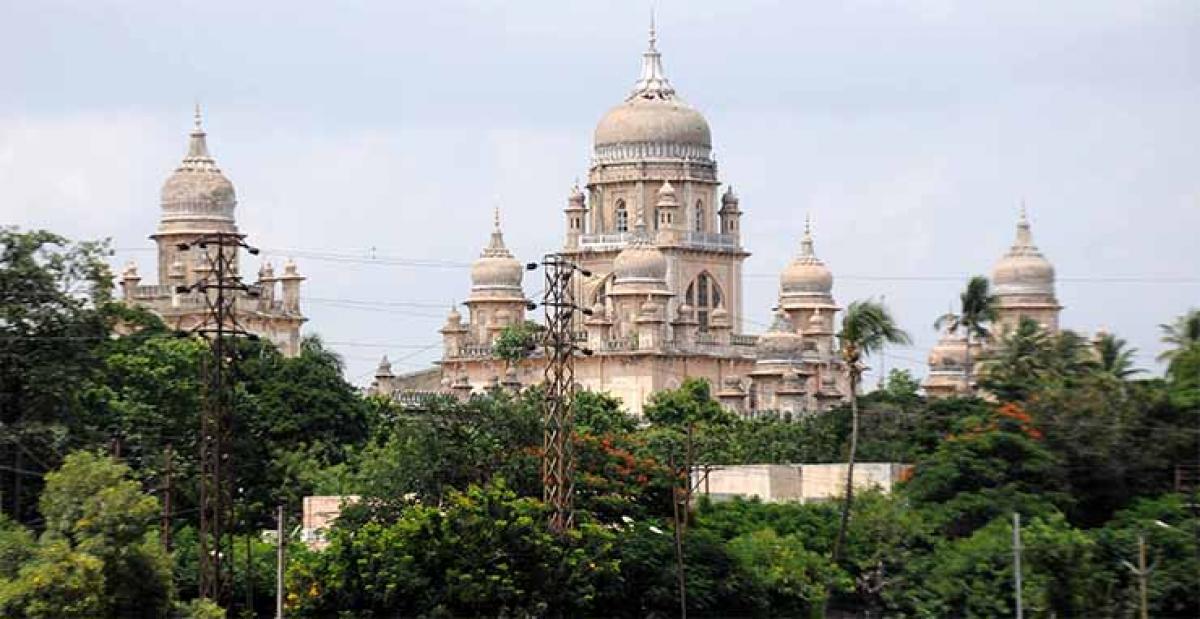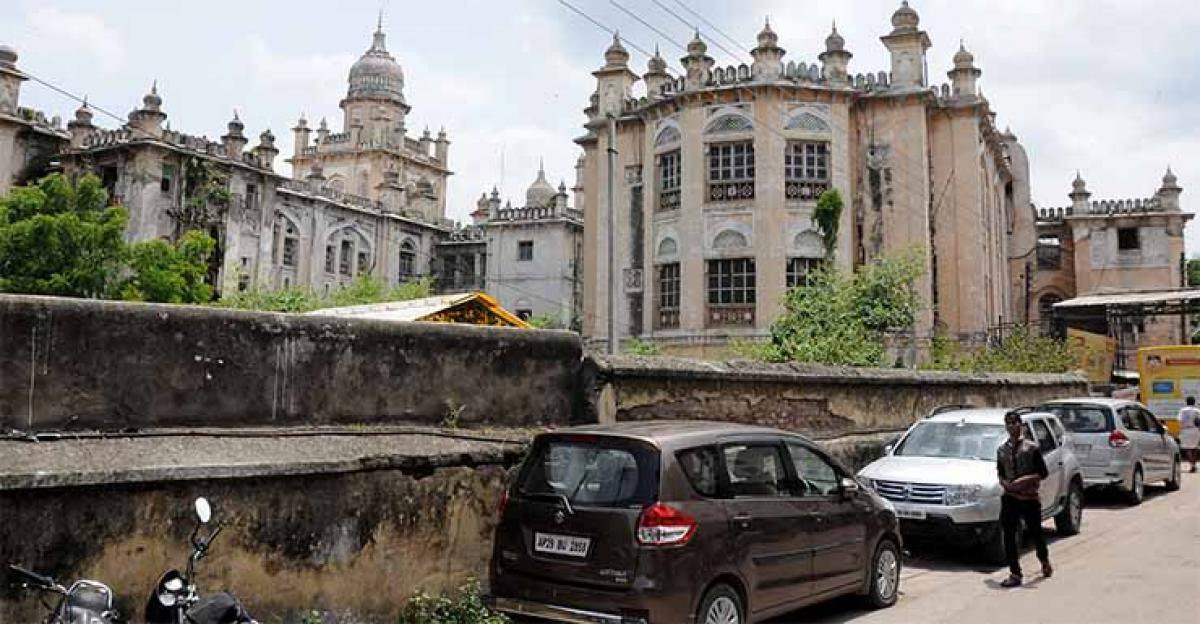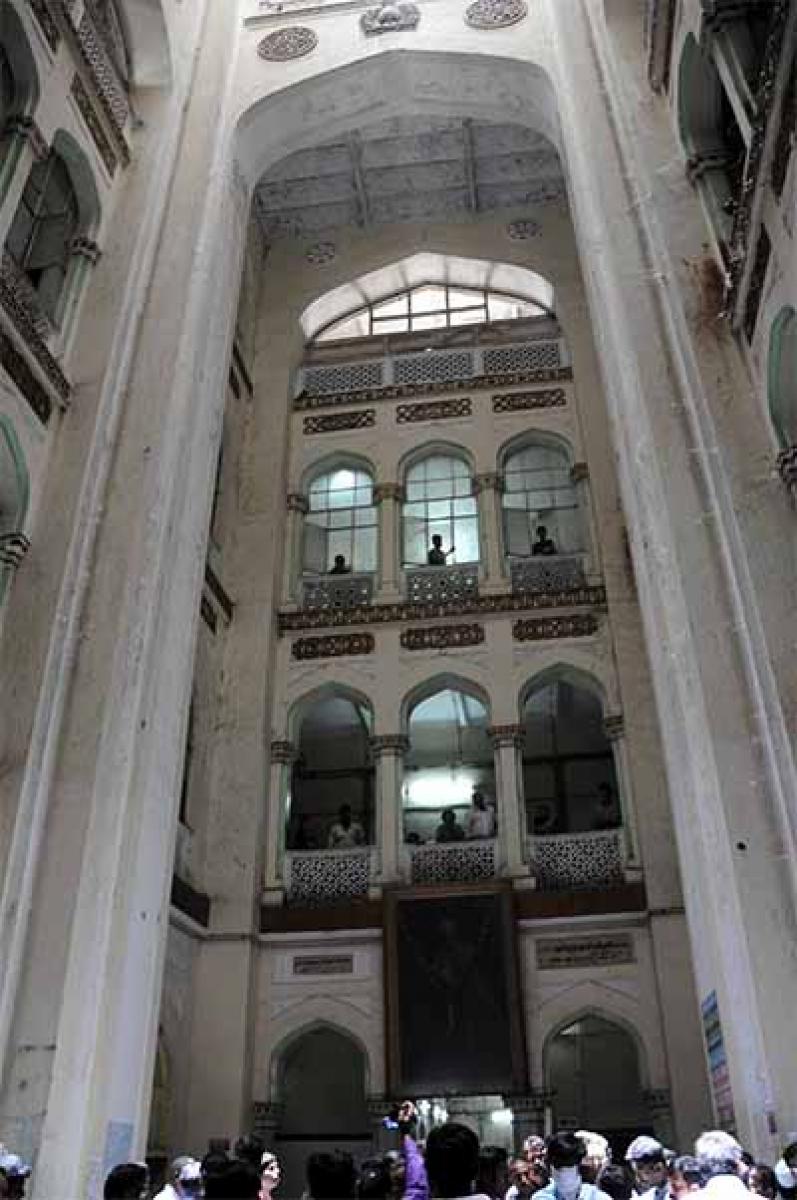Live
- Baisakh Month: A Time of Auspicious Beginnings and Sacred Festivals
- Oust BJD govt for overall development, says Shah
- Unveiling the Hidden Gems: Surprising Health Benefits of Garlic Peels
- Overcoming Sleep Struggles: A Comprehensive Guide to a Restful Night
- RTC bus hit the auto
- MLA Kuchukula Rajesh Reddy participated in the Birappa festival
- DMHO starts awareness campaign on Malaria
- World Intellectual Property Day 2024: Date, History, Significance, and Everything You Need to Know
- Shiv Sena-UBT manifesto assures dignity to all states; ‘no’ to polluting nuclear, refinery mega projects
- IPL 2024: Delhi Capitals sign Gulbadin Naib to replace injured Mitchell Marsh
Just In

A blend of tradition and modernity, a mosaic of different cultures, a cradle of civilisation that assimilated the best from every race and several landmarks that are unique to it, endow Hyderabad with a charm and character that is unrivalled. Its palaces, tombs, mosques and temples, the beautiful Hussainsagar, the water body that stands majestically in the centre separating the twin cities-
The argument on whether to conserve the Osmania General Hospital building in Hyderabad, or to demolish and make way for a modern building is substantiated by the views of experts like conservation architect GSV Suryanarayana Murthy and Dr Putta Srinivas, former Superintendent of Osmania General Hospital
.jpg)
A blend of tradition and modernity, a mosaic of different cultures, a cradle of civilisation that assimilated the best from every race and several landmarks that are unique to it, endow Hyderabad with a charm and character that is unrivalled. Its palaces, tombs, mosques and temples, the beautiful Hussainsagar, the water body that stands majestically in the centre separating the twin cities- Bristish cantonment inspired Secunderabad from the royally motivated Hyderabadis who love their leisurely life style all add to the allure of Hyderabad.
Hyderabadi lingo and Biryani have become very popular outside the boundaries of the state but the essence of Hyderabad and all that it stands for is reflected in its Indo-Sarcenic style of architecture and the warmth of the people who owned everyone who made their home here with their wonderful hospitality. The beautiful old buildings in this style of architecture however did not remain confined to monuments.
Several hospitals, the high court building and government offices too revelled in the pride of operating in these wonderful structures that have withstood the ravages of time. The beautiful building that houses the Osmania General Hospital completed in 1919 and designed by British architect Vincent Jerome Esch in the Indo-Sarcenic style is today at the centre of a major controversy with talks of the structure being razed to the ground doing the rounds.
The building with its palatial structure and typical domes stands on a 26.5 acre plot on the banks of the river Musi and has been an important landmark with its typical motifs like domes, chajjas and Merlons (parapets in medieval architecture) in Hyderabad adding to its charm and glory.

The reason stated for the present move is said to be the danger posed to the life of the patients and staff by the dilapidated building which is in an utter state of disrepair thanks to the neglect of its maintenance over the years. Views have been expressed that the building will be replaced by a modern multi level structure to suit the times. While safety of the inhabitants is undoubtedly a question of paramount importance and shifting them to other places is not an unreasonable gesture, the very premise of bringing down a slice of history has become an unpalatable reality to many citizens proud of it unique heritage.
People are also grimacing at the penchant of the rulers to build skyscrapers and ugly glass and mortar structures that have charmed them during their many travels abroad. Their decision to ape everything that they see outside the state boundaries and their obliviousness to the beauty that surrounds them, to many is absurd and inexplicable. Eminent writer and historian William Dalrymple who has a great connection with this historic city has called the move insane.
 “Hyderabad has the worst record in India for destruction of its Heritage. Everywhere else in the world there is a massive investment in museums and heritage but here the short sighted politicians want to destroy the very things they need to preserve,” he says. Statements by powerful people that they would not hesitate to bring the Charminar down if they discovered that it was structurally weak has strengthened Dalrymple’s observation and shocked activists, architects, historians, eminent Hyderabadis and all its citizens who find such statements insensitive and deplorable.
“Hyderabad has the worst record in India for destruction of its Heritage. Everywhere else in the world there is a massive investment in museums and heritage but here the short sighted politicians want to destroy the very things they need to preserve,” he says. Statements by powerful people that they would not hesitate to bring the Charminar down if they discovered that it was structurally weak has strengthened Dalrymple’s observation and shocked activists, architects, historians, eminent Hyderabadis and all its citizens who find such statements insensitive and deplorable.
Conservation architect GSV Suryanarayana Murthy had submitted a detailed report on the structure in 2013 at the instance of the Medical Infrastructure department had clearly stated that the building can be restored to its original glory and was not in a bad state as is being projected. Stating that they had restored a structure that had housed the irrigation department that was 90 percent damaged, he feels the main structure here can be retained by carrying out repairs that he had mentioned in his 40 page report that has obviously been set aside by the government.
“Stone structures have stood rock solid for centuries and to say that the hospital is beyond repair is a fallacy. The damages which are mainly on the surface due to lack of maintenance and natural decay in the case of organic material are well within the realm of repair. The cost of repair is much cheaper than dismantling the entire structure. Also can we replicate this kind of architecture ever?” Murthy asks.
Although conservation architects and members of Indian National Trust for Art and Cultural Heritage (INTACH) have been crossing swords with the Telangana government over the preservation of this Grade 11 A Heritage structure those from the medical fraternity like Dr Putta Srinivas, former Superintendent of Osmania General Hospital are all for having a new structure that can cater to the increasing population in place of the 858 bed hospital with its cracked domes, and porticos, flaking plaster and leaking water lines.
“I don’t understand the logic behind preserving a structure that can come crashing down any minute. At the rate the population is growing we need infrastructure to house 20 times the patients that were there when the structure was originally built. The hospital now has 39 super specialities and specialised equipment but the whole structure is in a precarious condition. Do we want doctors and patients to wear helmets and live in fear of the walls collapsing over them?” he asks.
Shifting the hospital to some other faraway place also doesn’t make sense as it will not serve the interest of poor patients who come to the hospital from different parts of the state, Dr Srinivas reasons. The argument that the, present building can be preserved as a monument and a modern hospital can be thought of on a ten-acre area in the vicinity of the building was also mooted a couple of years ago but was rejected by heritage activists on technical grounds.
Political and social analyst Dr Venugopala Reddy however feels that this proposal be considered after a detailed study by experts in the field. “Our history needs to be preserved but at the same time we need to look at the realities of governance, of having better medical care for the poor and taking tough decisions based on sound reasoning. Tomorrow if some disaster happens after spending crores on repairs, media headlines will talk of public money going down the drain,” he avers.
The Osmania General Hospital, conceived after the great flood of September 1908 is but one of the great structures dotting the great Muchkunda river which came to be called Musi. Several elegant structures, gardens, bridges and the great Tamarind tree which saved several lives during the great flood are all part of the Musi mystique. Every structure here is a monument of timeless elegance and every wall has a story to narrate.
The Government has neither been able to protect and restore the grandeur of the Musi river front despite crores of rupees being allocated for its restoration, nor has it been able to maintain the wonderful old structures by carrying out periodic repairs and maintenance. If the hospital is in such a terrible condition, whose fault is it? There are no answers to the apathy that envelopes the maintenance of all government buildings and this hospital in particular where visitors cannot enter without covering their noses with handkerchief is no exception.
The architect Vincent Esch had written many years ago “Let us keep India Indian and let her architecture flourish as it did years ago”. Neither the splendid work of the architect nor his words seem to have any impact as we go about gaping in wonder at marvels elsewhere. Opera houses from Sydney, Glass towers from Dubai.... cities that look like Kaulalampur and Singapore... things that fascinate our rulers are endless.
The fact that a Deccan trail on the lines of tourist attractions in Rajasthan or Goa can earn the government crores of rupees in tourism and much more in terms of pride escapes them. What can Hyderabadis say but caution them about the perils of looking yonder. Just pause and admire the beauty in your own backyard and do not destroy what you cannot recreate.
By:Aruna Ravikumar

© 2024 Hyderabad Media House Limited/The Hans India. All rights reserved. Powered by hocalwire.com







